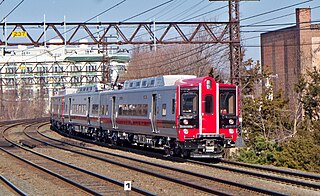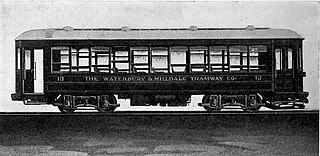
The New York, New Haven and Hartford Railroad, commonly known as The Consolidated, or simply as the New Haven, was a railroad that operated principally in the New England region of the United States from 1872 to December 31, 1968. Founded by the merger of the New York and New Haven and Hartford and New Haven railroads, the company had near-total dominance of railroad traffic in Southern New England for the first half of the 20th century.

The Providence and Worcester Railroad is a Class II railroad operating 612 miles (985 km) of tracks in Rhode Island, Massachusetts, and Connecticut, as well as New York via trackage rights. The company was founded in 1844 to build a railroad between Providence, Rhode Island, and Worcester, Massachusetts, and ran its first trains in 1847. A successful railroad, the P&W subsequently expanded with a branch to East Providence, Rhode Island, and for a time leased two small Massachusetts railroads. Originally a single track, its busy mainline was double-tracked after a fatal 1853 collision in Valley Falls, Rhode Island.

The New York and New England Railroad (NY&NE) was a railroad connecting southern New York State with Hartford, Connecticut; Providence, Rhode Island; and Boston, Massachusetts. It operated under that name from 1873 to 1893. Prior to 1873 it was known as the Boston, Hartford and Erie Railroad, which had been formed from several smaller railroads that dated back to 1846. After a bankruptcy in 1893, the NY&NE was reorganized and briefly operated as the New England Railroad before being leased to the competing New York, New Haven and Hartford Railroad in 1898.

The New Haven Line is a 72.7 mi (117.0 km) commuter rail line operated by the Metro-North Railroad in the U.S. states of New York and Connecticut. Running from New Haven, Connecticut, to New York City, the New Haven Line joins the Harlem Line in Mount Vernon, New York, and continues south to Grand Central Terminal in Manhattan. The New Haven Line carries 125,000 passengers every weekday and 39 million passengers a year. The busiest intermediate station is Stamford, with 8.4 million passengers, or 21% of the line's ridership.

The Waterbury Branch is a branch of the Metro-North Railroad's New Haven Line, running north from a junction in the Devon section of Milford to Waterbury, Connecticut. Originally built as the Naugatuck Railroad, it once continued north to Winsted. The part north of Waterbury is now leased from CTDOT by the Railroad Museum of New England, which operates excursion trains from Thomaston station through their operating subsidiary Naugatuck Railroad ; this name was chosen in homage of the original railroad. The trackage ends in Torrington, but Metro-North service on the branch ends at Waterbury. There are conceptual plans to extend service from its current terminus in Waterbury to Hartford via Bristol and New Britain. Currently, riders that want to continue to New Britain and Hartford have to transfer to an express bus operated by CTtransit at Waterbury. All trains on this branch operate as shuttles between Waterbury and Bridgeport.

The Connecticut Southern Railroad is a 90-mile (140 km) long short-line railroad operating in Connecticut and Massachusetts. The company was formed in 1996 as a spinoff of Conrail by shortline holding company RailTex and subsequently acquired in 2000 by RailAmerica. Since 2012, it has been a subsidiary of Genesee & Wyoming. CSO is headquartered in Hartford, Connecticut, site of its Hartford Yard. The company also operates East Hartford Yard.

CT Transit is a public transportation bus system serving many metropolitan areas and their surrounding suburbs in the state of Connecticut. CT Transit is a division of the Connecticut Department of Transportation, although it contracts a number of private companies for most of its operations. CT Transit began operations in 1976 as Connecticut Transit after the Connecticut DOT's acquisition of the Connecticut Company. Initially serving only the Hartford, New Haven, and Stamford areas, CT Transit's service now extends throughout much of Connecticut. CT Transit provides local "city bus" service in Bristol, Hartford, Meriden, New Britain, New Haven, Stamford, Wallingford and Waterbury in addition to a number of express routes connecting to outlying suburbs and other regions of the state.

The Third Avenue Railway System (TARS), founded 1852, was a streetcar system serving the New York City boroughs of Manhattan and the Bronx along with lower Westchester County. For a brief period of time, TARS also operated the Steinway Lines in Long Island City.
The Connecticut League, also known as the Connecticut State League, was a professional baseball association of teams in the state of Connecticut. The league began as offshoot of the original Connecticut State League, which dates back as far as 1884. In 1891, the Connecticut State League included the Ansonia Cuban Giants, a team made up of entirely African-American ballplayers, including future Hall of Famers Frank Grant and Sol White. In 1902, it was a Class D league with teams in eight cities. In 1905, the league became Class B, which lasted until 1913, when the league became the Eastern Association due to several teams outside of the state entering the league. Also a Class B league, it survived two more seasons, then folded after the 1914 season.
The Eastern Association was a minor league baseball league. The first version of the league appeared in 1882, followed by similar one season leagues in 1891 and 1909 with teams in Connecticut, New York, Pennsylvania and Rhode Island. The league was a Class B level league in the 1913 and 1914 seasons, with teams based in Connecticut and Massachusetts.
The Bridgeport Traction Company was a streetcar transit company in the area around Bridgeport, Connecticut. The company was incorporated in 1893 through the consolidation of the Bridgeport Horse Railroad Company, Bridgeport Railway Company, and the East End Railway Company. The East End Railway Company was established in 1895 as the Bridgeport and West Stratford Horse Railroad Company. The Bridgeport Horse Railroad Company was incorporated in 1864. The Bridgeport Railway Company was formed in 1893. At the time, streetcars were a more affordable form of transportation for those commuting between Bridgeport and Norwalk. Using streetcars to get to their destination was half the price of using the train. In 1899 president Andrew Radel formed a company that was intended to control the world's oyster trade.

The Connecticut Valley Railroad was a railroad in the state of Connecticut founded in 1868. The company built a line along the Connecticut River between Hartford and Old Saybrook, which opened in 1871. It was reorganized as the Hartford and Connecticut Valley Railroad in 1880, and leased by the New York, New Haven and Hartford Railroad in 1887. Following partial abandonments by the New Haven Railroad and successor Penn Central Transportation Company between 1968 and 1972, the line south of Middletown was revived as the Valley Railroad, a heritage railroad, while the portion in Middletown and northward saw operation by several freight railroads. As of 2022, the Providence and Worcester Railroad and Connecticut Southern Railroad both operate portions of the former Connecticut Valley Railroad.
The Shore Line Electric Railway was a trolley line along the southern coastline of Connecticut, running between New Haven and Old Saybrook with additional branches to Chester and Stony Creek. Unlike most trolley lines in New England, the Shore Line Electric was a true interurban, running large railway-style cars largely on a private right-of-way rather than on public streets. Though its main line was in operation for only 15 nonconsecutive years, the Shore Line Electric briefly acquired a substantial network of trolley lines stretching across eastern Connecticut, including the Norwich and Westerly Railway, the Groton and Stonington Street Railway, and several lines of the Connecticut Company. Most of the trolley line no longer is extant, however, the Shore Line Electric Railway Power House still stands along the mouth of the Connecticut River in Old Saybrook.

The New York and Stamford Railway was a streetcar line that connected the Westchester County suburbs of New Rochelle, Larchmont, Mamaroneck, Harrison, Rye, and Port Chester, with the Connecticut suburbs of Greenwich and Stamford. The company was formed in 1901 when the New York, New Haven and Hartford Railroad combined the Larchmont Horse Railway Company with the Port Chester Street Railroad Company. The Larchmont Horse Railway Company was founded in 1888 by the Larchmont Manor Company to construct a line from the New York, New Haven and Hartford Railroad Larchmont train station to its development 1.2 miles from town. The line was rebuilt for electric operation and extended to Harrison in 1901. The Port Chester Street Railroad opened in 1898 serving Port Chester, New York. The trolley line was soon extended west through Rye to Harrison in 1901. The two companies were merged that summer to form the New York and Stamford Railway. Trackage rights over the Westchester Electric Railroad were obtained for access to New Rochelle.
Connecticut Railway and Lighting Company was a streetcar and bus transit operator serving the region around Bridgeport, Norwalk, Derby, New Britain and Waterbury, Connecticut. It was formed in 1901 by United Gas Improvement Company of Philadelphia to manage the streetcar operations of the Connecticut Light and Power Company, which at the time included Central Railway and Electric Company, Norwalk Street Railway, and the Waterbury Traction Company. The newly formed Connecticut Railway and Lighting acquired Bridgeport Traction Company, Derby Street Railway, Milford Street Railway, Shelton Street Railway, Meriden, Southington and Compounce Tramway Company, and the Cheshire Street Railway. Connecticut Railway and Lighting was leased to the Consolidated Railway and in turn the Connecticut Company between 1906 and 1936. Streetcar operations were discontinued in 1937 when all lines were converted to bus. Transit operations continued until 1972, when all remaining bus operations were suspended and taken over by Connecticut Transit, except in Bridgeport- by the Greater Bridgeport Transit District in 1975.

Cedar Hill Yard is a classification yard located in New Haven, North Haven and Hamden, Connecticut, United States. It was built by the New York, New Haven and Hartford Railroad in the early 1890s in and around New Haven's Cedar Hill neighborhood, which gave the yard its name. Electrical catenary for electric locomotives was added to the yard in 1915. To handle increasing traffic as a result of World War I, the yard was greatly expanded between 1917 and 1920 with additional construction along both sides of the Quinnipiac River. The construction project added two humps where railroad cars were sorted into trains by gravity. The yard was further modernized in the 1920s, becoming one of the busiest railroad yards in the United States, and the most important yard in the entire New Haven Railroad system.

The Meriden, Waterbury, and Connecticut River Railroad was a railroad in the state of Connecticut. The charter, originally granted in 1871 to the Meriden and Cromwell Railroad, was obtained by Meriden residents and construction began in 1883. The line opened between the city of Meriden, Connecticut, and the Connecticut River in Cromwell, Connecticut, in 1885. An extension to Waterbury, Connecticut, was completed in 1888 as the Meriden and Waterbury Railroad, and the two companies merged to form the Meriden, Waterbury and Connecticut Railroad.

The Waterbury and Milldale Tramway was a streetcar line that operated between Waterbury and Milldale, Connecticut, United States. The line was 8.702 miles (14.00 km) long, including 1.385 miles (2.23 km) of trackage rights on a Connecticut Company line to reach downtown Waterbury. The company was chartered in June 1907 and began construction in mid-1912. It opened in stages, with the first section entering service on November 19, 1913, and the full line open on December 19, 1914. The line was soon unprofitable; the east portion was abandoned in October 1927, and the remainder in October 1933. A bus route that replaced the western portion continues to run as CTtransit route 425, operated by the Northeast Transportation Company. The Waterbury and Milldale was locally known as the "Green Line" after its green-painted streetcars, which included a pair of unique cars.
















